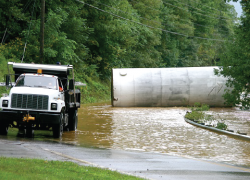
June is National Great Outdoors Month, a time to celebrate the world around us. Nature offers beauty, respite recreation and, for many people, a workplace. In the occupations shown below, workers may spend most or all of their days outside. And the Bureau of Labor Statistics projects that employment in each will grow faster than the 8% average for all jobs from 2020 to 2030. None of the selected occupations requires a college degree to enter. Check out these 10 occupations for which the outdoors is the office:
Agricultural equipment operators
What they do: These workers operate tractors, balers, threshers and other machinery to plow and sow seeds and to maintain and harvest crops. They also may adjust and make minor repairs to the equipment.
Projected employment growth, 2020–30: 13% (faster than average)
Number of jobs, 2020: 65,000
Projected openings, 2020–30: 11,700/year, on average
Median annual wage, 2021: $36,360
Typical entry-level education: No formal educational credential required
Typical experience required: None
Typical on-the-job training: One to 12 months
Amusement and recreation attendants
What they do: These workers have a variety of duties at places like golf clubs, stadiums and theme parks. For example, they may sell tickets, provide sporting equipment to participants or operate amusement rides.
Projected employment growth, 2020–30: 32% (much faster than average)
Number of jobs, 2020: 264,400
Projected openings, 2020–30: 72,900/year, on average
Median annual wage, 2021: $24,500
Typical entry-level education: No formal educational credential required
Typical experience required: None
Typical on-the-job training: One to 12 months
Captains, mates, and pilots of water vessels
What they do: Captains have overall command of a ship, including steering, directing the crew and keeping activity logs. Mates operate the ship when the captain is off duty. Pilots board the ship to guide it into the harbor or on rivers or other confined waterways.
Projected employment growth, 2020–30: 13% (faster than average)
Number of jobs, 2020: 29,900
Projected openings, 2020–30: 3,600/year, on average
Median annual wage, 2021: $81,640
Typical entry-level education: Postsecondary nondegree award
Typical experience required: Less than five years
Typical on-the-job training: None
Forest fire inspectors and prevention specialists
What they do: These workers assess outdoor fire hazards. They patrol areas, look for conditions that pose wildfire risks and recommend ways to reduce the threat of fire.
Projected employment growth, 2020–30: 24% (much faster than average)
Number of jobs, 2020: 3,000
Projected openings, 2020–30: 400/year, on average
Median annual wage, 2021: $42,600
Typical entry-level education: High school diploma or equivalent
Typical experience required: Less than five years
Typical on-the-job training: One to 12 months
Lifeguards, ski patrol, and other recreational protective service workers
What they do: These workers monitor beaches, ski slopes and other recreational areas to help keep visitors safe. They usually must be qualified to administer first aid to injured participants.
Projected employment growth, 2020–30: 24% (much faster than average)
Number of jobs, 2020: 117,500
Projected openings, 2020–30: 35,700/year, on average
Median annual wage, 2021: $25,630
Typical entry-level education: No formal educational credential required
Typical experience required: None
Typical on-the-job training: One month or less
Recreation workers
What they do: Recreation workers design and lead activities to help people stay active, improve fitness and have fun. They work with groups in summer camps, nature parks and other settings.
Projected employment growth, 2020–30: 16% (much faster than average)
Number of jobs, 2020: 354,100
Projected openings, 2020–30: 64,600/year, on average
Median annual wage, 2021: $29,680
Typical entry-level education: High school diploma or equivalent
Typical experience required: None
Typical on-the-job training: One month or less
Rotary drill operators, oil and gas
What they do: These workers set up or operate a variety of drilling rigs. Their work facilitates removal of underground oil and gas or of core samples for testing during oil and gas exploration.
Projected employment growth, 2020–30: 26% (much faster than average)
Number of jobs, 2020: 15,200
Projected openings, 2020–30: 2,400/year, on average
Median annual wage, 2021: $56,380
Typical entry-level education: No formal educational credential required
Typical experience required: None
Typical on-the-job training: One to 12 months
Solar photovoltaic installers
What they do: Solar photovoltaic installers assemble, set up and maintain rooftop or other systems that convert sunlight into energy. They install panels outdoors, but may have to work in attics and crawl spaces to connect the panels to an electrical grid.
Projected employment growth, 2020–30: 52% (much faster than average)
Number of jobs, 2020: 11,800
Projected openings, 2020–30: 2,300/year, on average
Median annual wage, 2021: $47,670
Typical entry-level education: High school diploma or equivalent
Typical experience required: None
Typical on-the-job training: One to 12 months
Tour and travel guides
What they do: These workers plan, organize and conduct long-distance or sightseeing tours, travel or expeditions. They may escort individuals or groups through public grounds or other places of interest.
Projected employment growth, 2020–30: 29% (much faster than average)
Number of jobs, 2020: 44,000
Projected openings, 2020–30: 9,200/year, on average
Median annual wage, 2021: $29,780
Typical entry-level education: High school diploma or equivalent
Typical experience required: None
Typical on-the-job training: One to 12 months
Wind turbine service technicians
What they do: Wind turbine service technicians install, maintain and repair machines that convert wind energy into electricity. Their work outdoors is often at great heights.
Projected employment growth, 2020–30: 68% (much faster than average)
Number of jobs, 2020: 6,900
Projected openings, 2020–30: 1,400/year, on average
Median annual wage, 2021: $56,260
Typical entry-level education: Postsecondary nondegree award
Typical experience required: None
Typical on-the-job training: More than 12 months
These are just a few of the many occupations that involve working outside. From arborists to zoologists, opportunities abound for outdoor enthusiasts at a variety of education levels. Explore options in the Occupational Outlook Handbook, and visit the Occupational Requirements Survey program for data on environmental conditions, such as working outdoors.

 U.S. Department of Labor Blog
U.S. Department of Labor Blog




